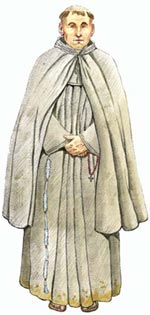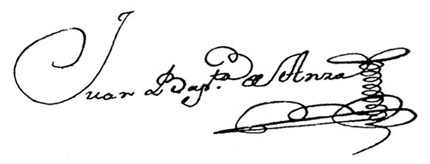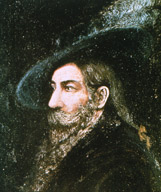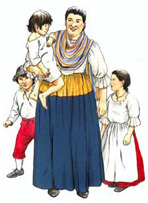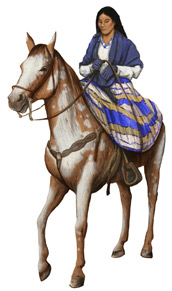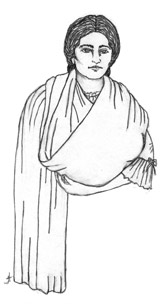
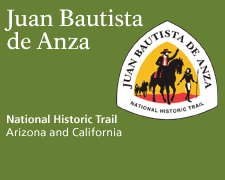 |
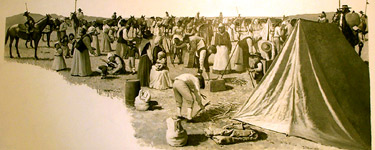 The Anza expedition looked like a traveling city. Graphic: Wade Cox |
| Santa Cruz County - Nogales to Tubac Presidio |
| To download as a PDF, click here (1.4 Mb). Viewable with Adobe Acrobat Reader |
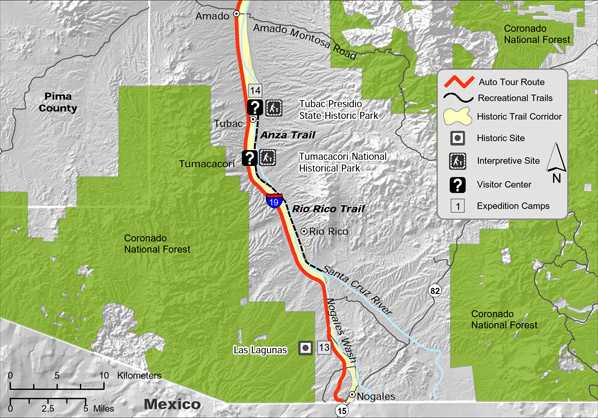 |
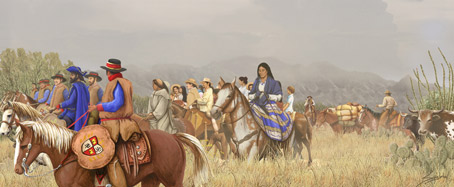
"ˇVayan subiendo!" - "Everybody mount up!" This was the command Anza sang out to begin the expedition's travels. The order of the train was specific with Anza coming first followed by the colonists and animals.
Graphic: Bill Singleton
Driving Directions for Auto Route
From the international border, the trail heads due north, paralleling Nogales Wash and later follows along the Santa Cruz River. Travel north from the Port of Entry on Business Loop I-19, and connect with northbound I-19. Visit historic sites tied to the Anza expedition such as Tumacácori National Historical Park and Tubac Presidio State Historic Park. To continue on the route, see Pima County.
Hiking/Biking Ideas
Along the several miles of trails in Río Rico, look for two stone trail orientation signs. There is a 4.5-mile trail between Tumacácori and Tubac (off of I-19) managed by the Anza Trail Coalition of Arizona and open to the public. The trail also extends north from Tubac for about a mile. It is about 1.25 miles from either trailhead to the first river crossing. The frontage road along Interstate 19 offers biking opportunities.
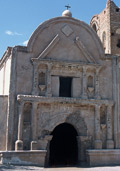
Tumacácori (left), pronounced Toomah- káh-core-ee, is located on 45 acres and contains the ruins of three missions.
The missions at San José de Tumacácori and Los Santos Ángeles de Guevavi were both established around 1691 and are the two oldest missions in Arizona. Mission San Cayetano de Calabasas derives its name from the Spanish word calabaza. This refers to the wild yellow gourds (Cucurbita foetidissma) that grow nearby. Guevavi is likely from a Piman word.
An ongoing project (Mission 2000) at Tumacácori involves imaging and translating Spanish documents. It has shown that many Anza expedition families raised children, lived and worshiped nearby.
Photo: Ron Ory
The Juan Bautista de Anza National Historic Trail starts here. Anza began recruiting settlers and soldiers in the Spring of 1775. They assembled in San Miguel de Horcasitas (now in Mexico) and departed on September 29, 1775, heading north. The final assembly was at Tubac Presidio, where they left Spanish civilization behind and traveled 890 miles to Monterey, California.
Sites of Interest
A. Las Lagunas and Expedition Camp #13
This campsite in Nogales is at a cienaga, or marsh, which is in private hands. It can be viewed by taking exit 5 off of northbound I-19 to Country Club Drive North and turning west. Park in the St. Andrew's Church parking lot, but do not overstay your welcome, since it's private land. The Desert Shadows Middle School in Nogales is home to a large Anza mural.
B. Río Rico Trail
Starting at the staging area parking lot off of Río Rico Rd., several miles of trail parallel Anza's route. From here, one can bike or walk to Tumacácori if it's not too hot. Look for several small stone trail signs.
C. Tumacácori National Historical Park
Mission San José de Tumacácori is located on highway I-19 about 18 miles north of Nogales, and was first listed in 1691 as an outlying visita (a mission station without a resident priest) by the famous Jesuit missionary
Father Eusebio Francisco Kino. By 1701, the village was a visita of the mission at Guevavi, and in 1771, Tumacácori
was made the head mission of the district, and Guevavi was
abandoned. San Cayetano de Calabasas is the adobe remnants of a site first occupied about 1756 as a Spanish mission visita.
Father Pedro Font held mass here on October 17, 1775, as the expedition moved toward Tubac. Construction of the present
mission church was begun around 1802. The visitor center is a National Historic Landmark and includes a museum. Visits to Calabasas and Guevavi can be arranged at the park's headquarters. A trail connects Tumacácori and Tubac along the Santa Cruz river through beautiful riparian habitat containing cottonwoods
and mesquite. Look for several large ramadas enclosing
interpretive panels about Anza's expeditions and the natural history of the area.
D. Tubac Presidio State Historic Park and Expedition Camp #14
Anza served as the Presidio de San Ignacio de Tubac's second commander from 1760-1776. About fifty cavalrymen were stationed at this remote outpost, founded in 1752 in response to an uprising by the local Akimel O'odham (Pima) tribe.
Anza's house, made of adobe bricks, was located here in what is now Tubac Presidio State Historic Park (four miles north of Tumacácori, Tubac Rd. and Presidio Dr.). The adjacent
area was the old Tubac Barrio (community). Today, it's managed by the Archeological Conservancy, and they arrange visits. A group called Los Tubaqueños offers period interpretation at the park. A re-enactment of the expedition's passage through Tubac takes place annually during the Anza Days.
|
Then, we began to march, I intoned the Alabado, to which all the people responded; and this was done every day both going and coming. When the campsite was reached, after all the people had dismounted the lieutenant came to report to the commander whether everything had arrived, or if something had remained behind, in order that he might give suitable orders. At night the people said the Rosary in their tents by families, and afterward they sang the Alabado, the Salve, or something else, each one in its own way, and the result was a pleasing variety." From Anza's Diary - First page "Diary of the march and explorations which I, the undersigned lieutenant colonel and captain of the Royal presidio of Tubac in the province and government of Sonora , am making a second time from the foregoing province to northern California. By order of the most excellent Señor Baylio Frey Don Antonio María Bucareli y Ursúa, Viceroy, Governor, and Captain-General of New Spain, as is shown by his superior decree of the 24th of November of the past year of 1774, for the purpose of escorting thirty soldiers with their commander and sergeant to the California named, for the reinforcement of the Royal Presidio of San Carlos de Monte Rey, and for the establishment of the port of San Francisco, all married and all recruited in the province named, and whose women and children and other dependents are set forth more at length below, together with the total number of those going upon this expedition..."
|
|||||||||||||||||||||||||||||||
| About Juan Bautista de Anza in Santa Cruz County |
|
Don Juan Bautista de Anza was 39 years old when the 1775-76 colonizing
expedition left for California. He was born in Fronteras in Sonora,
New Spain, in 1736. His father, also named Juan Bautista, was the
commander of the Presidio at Fronteras; he was killed in a battle
with the Apache Indians there when Juan was three or four years
old.
When Anza returned to Sonora (now in Mexico), he was rewarded and promoted to Lieutenant Colonel. In 1775, he was given orders to recruit soldiers with families, and to escort them to Alta California so that they could establish a colony at the port of San Francisco. In spring of 1775, he began recruiting and enlisting soldiers with families starting in the town of Culiacán (in Sinaloa), and swept northward on his campaign. He must have made a convincing argument, since he could offer them only an immediate salary as well as food, clothing, and transportation to a land that was wilderness and a great unknown. Anza was away on two trips to Alta California; his wife remained in Tubac. Anza would be away for about eight months during the 1775-76 colonizing expedition serving his king, Carlos III of Spain. |
||||||||||||||||||
| About the Anza Expedition in Santa Cruz County |
The Anza expedition had to carry the supplies needed to keep the
group safe, fed, and healthy. Almost all of it was carried by mules.
Don José de Echeveste drew up a detailed
list of estimated costs for Anza's 1775-1776 expedition on December
5, 1774. He calculated it in the money of the time, Spanish pesos
and reales,
eight reales being worth one peso; 45 1/2 reales was
equivalent to about one (1998) U.S. dollar.
Food rations included cattle (one for each day), 30 loads of flour for tortillas, pinole, kidney beans, 6 cases of ordinary chocolate, white sugar, soap, and 3 barrels of aguardiente (brandy) for "needs that arise." As it turned out, this would be used for the expedition's fandangos. For cooking, there were 8 iron pans, 10 copper campaign kettles, and 12 large chocolate-pots. Military supplies included a flag with the royal coat of arms, 11 tents of unbleached canvas, 20 carbines (rifles), 10 ball cartridges, 40 leather flasks for gun powder, swords and lances, 22 leather jackets, plus gear for the horses and pack mules. Tools included 4 Biscayan hatchets with a steel edge, 4 spades, 4 shovels, a crow-bar, 1 tool chest. There were also 2 blank books for military registers and the diaries. Without these we would know much less about the expedition. Thanks to the diaries, we can read about the daily trials of the expedition over 225 years after they made their journey. And let's not forget that there were gifts for the American Indians that Anza would meet along the way, including 6 boxes of beads. A blue cloth cloak, a jacket and buckskin beeches were given to the the chief of the Quechan tribe at Yuma (Salvador Palma). When all was accounted for, the expedition cost less than $500 U.S. dollars. That's a pretty good investment on the part of the Spanish government to secure the claim it had to California and the west. |
||||||||||||
|
|
|||||||||||||||||||||||||||||||||||||||||||||||||||||||||||||||||||||
|
||||||||||||
Click to open Activity in a new window, print that page to use for the activity, and then close the window when finished. |
|||||
Back to Juan Bautista de Anza Trail Guide Homepage. |
||
| Disclaimer | Accessibility | Privacy Policy | FOIA | Notices | USA.gov |
